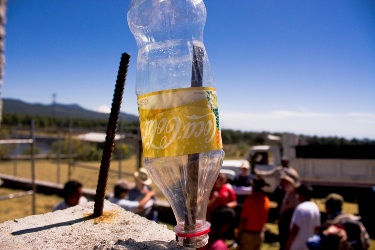Coajomulco is a mountain community of indigenous people located just outside Cuernavaca City in the state of Morelos, Mexico. These people are literally having their water taken out from under them. The members of the community I spoke with included: Beatrice a community elder, Alfonso and Rodriguez, who worked together to organize the community and the building of the reservoir system.
Most of the photos leave these people unidentifiable because there were concerns expressed in conversation with community members about repercussions of speaking out against the government and multinational corporations. Also, this approach is symbolic of the namelessness of the community members and their lack of voice and power.
The Mexican government does not recognize indigenous communities as possible beneficiaries of local water resources and does not allow these communities to participate in the legal proceedings surrounding water concessions which doles out the water use within Mexico.

These residents have no water in their homes. The reservoirs are located miles outside of the community up the mountain. The water is collected in the reservoirs without proper treatment, is contaminated and unusable for most of the community needs. Ironically, residents are forced to purchase purified bottled water for drinking, cooking, etc. Most of this drinkable water is expensive and bottled by multi-national soft drink companies.

Yet, living in a volcanic mountain range, Coajomulco is a location which would be ideal for filtering water. The residents have been told by the government that they cannot dig a well to access the subterranean water beneath them, which would be suitable for their needs. Instead, this water is rerouted to the larger cities of Cuernavaca and Mexico City. The government provides this water, at a cost, for residential and industrial needs — including a major Coca-Cola bottling plant.
Making Coca-Cola uses up at least two litres of water to make one litre of the soft drink. Some studies believe the ratio to be even higher. Since 2000, Coca-Cola has negotiated 27 water concessions with the Mexican government which gives them the right to extract water from 19 aquifers and 15 rivers, many found within indigenous territories throughout the country.

According to an interview done on website oaxacalibre.com on September 11, 2007 with APPO (Asamblea Popular de los Pueblos de Oaxaca, an umbrella organization which unites labour unions, farmers’ organizations, neighbourhood committees, organizations of indigenous peoples, women’s groups, regional groups, and concerned individuals), activist Florentino Lopez said there was an unhealthy relationship between Oaxaca state governor Ulises Ruiz and Coca-Cola.
“It seems to us that Ulises has, in the first place, sought the backing of businesses and primarily the transnationals… We have denounced the case of Coca-Cola… which established a series of agreements… to exploit the hydraulic resources and which received several objections, for example the case of the neighbours of Viguera, when they were blocking the well located near the Juarez Monument.

“They informed us that the State Institute for Water and the National Water Commission had contracted with the Coca-Cola company to drill wells in this zone of Viguera and in other places like Huitzo, Telixtlahuaca and Etla, which have below-ground aquifers. And while the neighbourhoods and districts have solicited drilling for the benefit of the communities they have not been given permission; Coca-Cola has several wells drilled in this zone that have been granted by agreement with the government of Ulises Ruiz Ortiz.”
After the people of Coajomulco invested much of its own time and money into these reservoirs, the municipal government recognized the community’s need for a water system and built an aqueduct system to aerate and filter the water, making it usable for livestock and household needs such as for bathing, laundry, and flushing toilets.

But the water is pumped to the filtration system from what has been collected from the reservoirs, but there is not enough water to run it and the system sits with stagnant, unusable water. The gates have been locked for so long that the rusted lock had to be cut off to open it. This attempt at independence seems to have failed.
Meanwhile, Mexico is the world’s leading consumer of Coke — and perfectly usable water remains just below the feet of the people of Coajomulco.
The photos were taken by Kristen Hansen in Coajomulco, Mexico on February 21 and 22, 2010.



